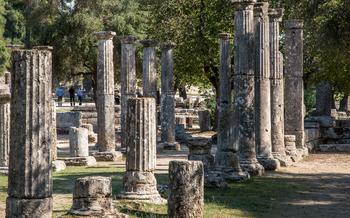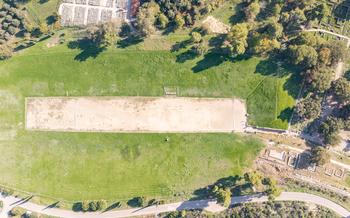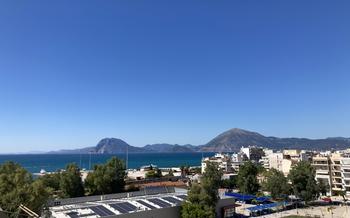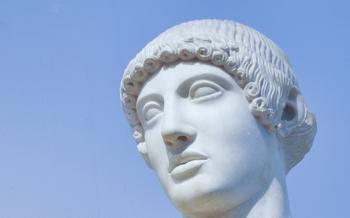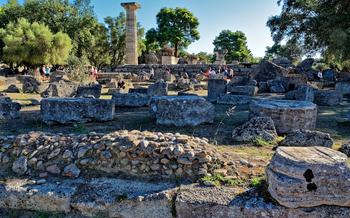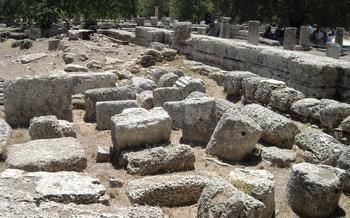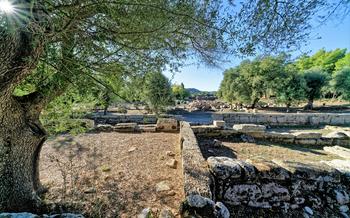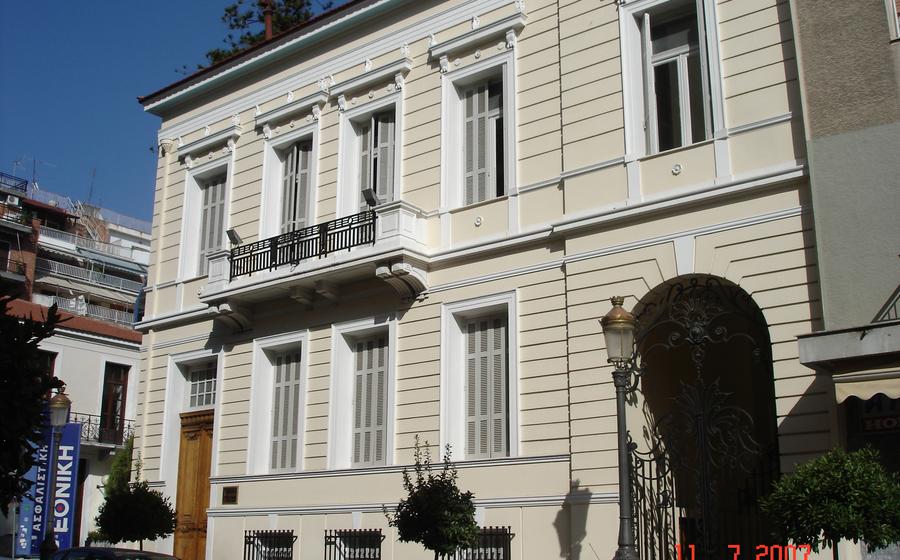
The Temple of Apollo Epicurius at Bassae
- A Temple Built for Apollo
- Unveiling the Temple's History
- Architectural Marvel
- Exploring the Temple's Interior
- Admire the Sculptures
- Temple's Surroundings
- Pilgrimage to Bassae
- UNESCO World Heritage Site
- Visiting the Temple
- Nearby Attractions
- Photography Tips
- Accommodation Options
- Insider Tip: Unveiling the Temple's Enchantment at Sunset
A Temple Built for Apollo
The Temple of Apollo Epicurius at Bassae is an ancient Greek temple located in the Peloponnese region of Greece. Constructed in the 5th century BC, the temple is a testament to the architectural prowess and religious beliefs of the ancient Greeks. Dedicated to Apollo Epikourios, the healer, the temple served as a place of worship and pilgrimage, attracting people from all over the region seeking divine intervention and protection.
The temple's unique Doric architectural style sets it apart from other Greek temples. The use of local limestone in its construction gives it a distinctive golden hue, which stands out against the surrounding landscape. Situated on a hilltop overlooking the Bassae Valley, the temple's strategic location allowed it to be visible from afar, serving as a beacon of hope and healing for those in need.
The temple's dedication to Apollo Epikourios, the healer, is significant. Apollo was one of the most revered gods in ancient Greece, and his association with healing made the temple a popular destination for those seeking relief from illness or injury. The temple's construction reflects the deep faith and devotion of the ancient Greeks, who believed in the power of divine intervention and sought Apollo's protection and guidance.
Unveiling the Temple's History
The Temple of Apollo Epicurius at Bassae stands as a testament to the architectural prowess of ancient Greece. Its construction dates back to the 5th century BCE, a period marked by significant cultural and artistic achievements in the region. The temple's origins are closely linked to the renowned architect Iktinos, who is also credited with designing the Parthenon in Athens.
Under Iktinos's guidance, the temple's construction employed a unique combination of Doric and Ionic architectural elements. This innovative approach resulted in a harmonious blend of strength and elegance, showcasing the versatility of ancient Greek architecture.
Despite its remote location, the temple's existence remained known throughout antiquity. However, it fell into disuse and was eventually abandoned, succumbing to the ravages of time and natural elements. Centuries passed, and the temple became lost to human memory, buried beneath layers of earth and vegetation.
In the 18th century, a fortuitous discovery brought the temple back into the light. A group of European travelers, captivated by the allure of ancient Greece, stumbled upon the ruins while exploring the Peloponnese region. This rediscovery sparked renewed interest in the temple, leading to extensive archaeological excavations and restoration efforts.
Today, the Temple of Apollo Epicurius stands as a majestic symbol of ancient Greek civilization. Its enduring legacy serves as a reminder of the region's rich history and cultural heritage, inviting visitors from around the world to explore its timeless beauty and architectural wonders.
Architectural Marvel
The Temple of Apollo Epicurius stands as an architectural marvel, showcasing an exceptional state of preservation and intricately designed elements. Constructed using local limestone, the temple's exterior exudes a warm golden hue that blends seamlessly with the surrounding natural landscape. Its unique features, including the iconic colonnade, set it apart from other temples of its time.
The temple's Doric architectural style is evident in its sturdy columns, fluted in a precise and harmonious manner. The colonnade features 6 columns across the front and rear and 15 columns along the sides, creating a sense of symmetry and balance. The columns support a beautifully crafted entablature adorned with triglyphs and metopes, which once housed exquisite sculptures that depicted various mythological scenes.
The temple's interior, divided into three sections – the pronaos, cella, and opisthodomos – reveals a layout that is both functional and aesthetically pleasing. The cella, which is unusually large for temples dedicated to Apollo, was likely used for religious ceremonies and offerings. The absence of cult statues within the temple adds to its mystique, inviting visitors to contemplate the significance and symbolism of this sacred space.
The Temple of Apollo Epicurius has had a profound influence on the development of Greek and Roman architecture. Its innovative design and exceptional craftsmanship served as a model for later temples and buildings, contributing to the evolution of classical architecture. Its enduring legacy is a testament to the skill and artistry of the ancient Greeks, who created structures that continue to inspire and awe visitors to this day.
Exploring the Temple's Interior
The Temple of Apollo Epicurius, despite its compact size, is divided into three distinct sections: the pronaos, the cella, and the opisthodomos. The pronaos, or porch, greets visitors with an impressive colonnade of six Doric columns, leading into the cella, the temple's main chamber. Here, visitors are greeted by a unique feature: the presence of a cella, a characteristic uncommon in temples dedicated to Apollo. This cella, which would have housed the cult statue of the deity, is noticeably devoid of any statues, a mystery that has intrigued archaeologists and historians alike.
Excavations conducted at the temple have unearthed various inscriptions and artifacts that shed light on its history and significance. These discoveries, including votive offerings, pottery fragments, and inscriptions, provide valuable clues about the rituals and ceremonies that took place within the temple's sacred walls. The absence of cult statues within the cella has led to speculation that the temple may have been dedicated to a more abstract or symbolic representation of Apollo, rather than a physical idol.
Admire the Sculptures
The Temple of Apollo Epicurius at Bassae is renowned for its exquisite sculptures, which once adorned the temple and showcased the exceptional artistic skills of the ancient Greeks. The pediments, triangular gables located at the front and rear of the temple, depicted mythological scenes with intricate details and lifelike figures. The eastern pediment showcased the battle between the Lapiths and Centaurs, while the western pediment portrayed the struggle between Apollo and Hercules for the possession of the Delphic tripod.
Equally impressive are the metopes, which were carved stone panels located above the colonnade. The metopes depicted the twelve labors of Hercules, showcasing his strength and courage as he faced various challenges. The sculptures exhibited a mastery of anatomy and movement, capturing the essence of each labor and bringing the stories to life.
The influence of these sculptures on the development of Greek art cannot be overstated. They represented a transition from the archaic style to the classical style, characterized by greater naturalism and realism. The sculptures at the Temple of Apollo Epicurius served as a model for subsequent Greek artists, who adopted and refined the techniques and styles pioneered at Bassae.
Temple's Surroundings
The Temple of Apollo Epicurius is nestled amidst a breathtaking natural landscape that enhances its allure. The surrounding hills and valleys offer panoramic views that will leave you spellbound. As you stand before the temple, the vastness of the natural beauty that envelops it will embrace you.
Take a moment to explore the temple's surroundings. Discover ancient ruins and archaeological sites that speak of a rich history. Immerse yourself in the tranquility of the natural world as you wander through the picturesque landscape.
For those who seek adventure, the region offers numerous hiking trails that traverse the stunning countryside. Lace up your hiking boots and embark on a journey through the hills, where you'll be rewarded with breathtaking views and a deeper appreciation for the temple's natural setting.
Pilgrimage to Bassae
The Temple of Apollo Epicurius at Bassae held an important place in the religious life of ancient Greece. It served as a pilgrimage site for those seeking healing and protection from Apollo, the god of healing, music, and prophecy. People from all over the region would travel to Bassae to pray, offer sacrifices, and seek guidance from the oracle.
The temple was believed to possess a powerful healing energy, and many pilgrims came seeking relief from various ailments. They would bathe in the nearby sacred spring and offer prayers and sacrifices to Apollo. The temple's priests would perform special rituals and ceremonies aimed at facilitating healing and protection.
The temple's reputation for healing extended beyond physical ailments to include emotional and spiritual healing as well. People would come to Bassae seeking solace, comfort, and guidance during times of difficulty or uncertainty. The temple provided a sanctuary where individuals could connect with the divine and find inner peace and renewal.
Even today, the temple continues to hold a spiritual significance for many visitors. While the ancient rituals and ceremonies are no longer performed, the temple's serene atmosphere and powerful energy still attract people seeking a spiritual connection and a deeper understanding of ancient Greek culture and religion.
UNESCO World Heritage Site
The Temple of Apollo Epicurius at Bassae stands as a testament to ancient Greek architecture and religious beliefs. Its exceptional state of preservation and unique features have earned it recognition as a UNESCO World Heritage Site.
UNESCO's World Heritage List includes cultural and natural sites of outstanding universal value. The Temple of Apollo Epicurius meets several criteria for inclusion on this prestigious list.
Firstly, it represents a masterpiece of human creative genius. The temple's innovative design, exceptional sculptures, and harmonious proportions showcase the architectural prowess of the ancient Greeks.
Secondly, it bears witness to a significant cultural tradition. The temple was a sacred site dedicated to Apollo, one of the most important gods in the Greek pantheon. It played a crucial role in religious rituals and ceremonies, and its construction reflects the deep spirituality of the ancient Greeks.
Thirdly, the temple is an outstanding example of a building type that illustrates a significant stage in human history. It represents the transition from Archaic to Classical Greek architecture and exemplifies the development of the Doric style.
UNESCO's recognition of the Temple of Apollo Epicurius underscores its importance as a cultural heritage site of global significance. It highlights the need to preserve and protect this architectural masterpiece for future generations.
Visiting the Temple
Planning a visit to the Temple of Apollo Epicurius at Bassae is a rewarding experience that allows you to immerse yourself in ancient Greek history and culture. The temple is open to the public daily, and admission fees are charged to help preserve and maintain this important archaeological site.
To make the most of your visit, it's recommended to plan your trip during the spring or fall months when the weather is pleasant, and the crowds are smaller. The temple is accessible by car, and ample parking is available nearby. For those arriving by public transportation, there are regular bus services from Athens and other major cities.
Accessibility for visitors with disabilities is a priority at the Temple of Apollo Epicurius. The site features wheelchair-accessible ramps and pathways, ensuring that everyone can enjoy and appreciate this ancient wonder.
Before your visit, consider contacting the archaeological site directly for any updates on opening hours, special events, or guided tours. The friendly and knowledgeable staff will be happy to assist you and provide further information to enhance your experience at the temple.
Nearby Attractions
The Temple of Apollo Epicurius at Bassae is not the only ancient site worth exploring in the region. Just a short drive away, visitors can discover the ancient city of Phigaleia, with its well-preserved theater and fortifications. For a glimpse into the region's Byzantine past, the nearby village of Andritsaina boasts several historic churches, including the impressive Church of the Dormition of the Virgin Mary.
If you're looking for a change of pace, the surrounding towns and villages offer a range of accommodation and dining options. Sample the delicious local cuisine, enjoy a leisurely stroll through the charming streets, or simply relax and soak up the atmosphere.
To fully immerse yourself in the region's rich culture and traditions, be sure to check out the various festivals and events held throughout the year. From traditional music and dance performances to culinary celebrations, these events offer a glimpse into the vibrant heart of the Peloponnese.
If you have time, consider taking a day trip to other destinations in the Peloponnese, such as the ancient city of Olympia, the medieval town of Monemvasia, or the stunning beaches of the Mani Peninsula. The region is home to a wealth of historical, cultural, and natural attractions, ensuring a truly unforgettable travel experience.
Photography Tips
The Temple of Apollo Epicurius at Bassae offers a stunning subject for photography enthusiasts. To capture its beauty effectively, consider the following tips:
-
Golden Hour Magic: Aim to visit the temple during the golden hours, just after sunrise or just before sunset. The warm, diffused light during these times enhances the temple's architectural features and creates a magical atmosphere.
-
Composition and Perspective: Experiment with different angles and perspectives to create dynamic compositions. Capture the temple's grandeur by including the surrounding landscape or focus on its intricate details for a more intimate shot.
-
Interior Details: Don't forget to venture inside the temple to capture the unique features of its interior. The play of light and shadow within the cella creates dramatic effects that are worth exploring.
-
Tripod Stability: Use a tripod to ensure sharp and steady shots, especially when photographing in low-light conditions. This will minimize camera shake and allow you to capture the temple's details with precision.
-
Lens Choice: A wide-angle lens is ideal for capturing the temple's imposing presence and its relationship with the surrounding environment. For close-up shots of specific architectural elements, a telephoto lens can be useful.
Accommodation Options
When planning your visit to the Temple of Apollo Epicurius, an array of accommodation options awaits you, catering to diverse preferences and budgets. Nestled in the picturesque surroundings of Bassae, you can choose from cozy hostels and guesthouses to sophisticated hotels that offer a range of amenities.
For budget-conscious travelers, hostels provide a comfortable and affordable stay, allowing you to mingle with fellow adventurers and share stories of your explorations. Alternatively, guesthouses offer a more intimate experience, often run by friendly locals who can provide valuable insights into the region.
If you seek a touch of luxury, indulge in the comforts of a nearby hotel. These establishments often boast stunning views of the temple and the surrounding landscape, along with a host of amenities to ensure a memorable stay. From elegant rooms and delectable dining options to rejuvenating spas, these hotels offer a haven of relaxation after a day of exploring ancient wonders.
To secure the best deals and avoid disappointment, it's advisable to book your accommodation in advance, especially during the peak tourist season. The convenience of staying close to the temple allows you to fully immerse yourself in its history and beauty, with easy access for early morning visits or sunset strolls.
Insider Tip: Unveiling the Temple's Enchantment at Sunset
As the sun begins its descent, casting a warm golden glow across the landscape, the Temple of Apollo Epicurius at Bassae transforms into a sight of unparalleled beauty. The interplay of light and shadow reveals intricate details of the temple's architecture, creating a magical atmosphere that transports visitors to another era.
This is the perfect time to capture stunning photographs of the temple against the backdrop of the golden sky. The warm hues of the sunset enhance the temple's grandeur, making it a sight to behold.
Whether you're a seasoned photographer or simply someone who appreciates the beauty of nature and history, visiting the Temple of Apollo Epicurius at sunset is an experience not to be missed. It's a chance to witness the temple in a new light, revealing its hidden charm and leaving you with lasting memories of your time in Bassae.

